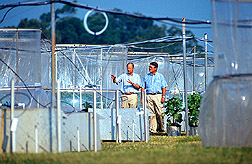This page has been archived and is being provided for reference purposes only. The page is no longer being updated, and therefore, links on the page may be invalid.
|
Read: more in the April issue of Agricultural Research magazine. |
Ozone: New Wrinkle in Crop Yield ProjectionBy Judy McBrideApril 21, 2000 By 2050, the amount of carbon dioxide in the atmosphere is expected to be twice preindustrial levels. And research shows that extra CO2 in the atmosphere stimulates growth and increases yield in a variety of food and fiber crops. But does it really? Agricultural Research Service scientists in Raleigh, NC, are finding that the air pollutant ozone is adding another wrinkle to models that predict food supply based on projected CO2 levels. Studies conducted by Joseph Miller, Allen Heagle, Edwin Fiscus and Fitzgerald Booker suggest that the models may often overestimate the impact of CO2 enrichment because they don’t also factor in ozone. Extra CO2 by itself will stimulate some growth because plants have more “food” for photosynthesis. Ozone, on the other hand, damages plant tissue and decreases crop yield. But extra CO2 partially closes the leaf pores, or stomates, through which plants exchange gases. This reduces the ozone that gets in and the water vapor that gets out. So if plants are under ozone or water stress, CO2 enrichment elicits a greater response. The more ozone stress, the more damage prevention by CO2 and the greater the apparent stimulation of plant growth. When the Raleigh scientists grew plants under low ozone, increasing CO2 concentration didn’t always stimulate growth appreciably. So far, they have seen this interaction in field tests of soybeans, winter wheat, rice, and cotton and in greenhouse tests of snap bean and white clover, a forage crop. Each crop or variety responded to a greater or lesser degree, depending on its sensitivity to each gas, but the trend was the same. This suggests that crop yields in high CO2 environments may not be as high as models have suggested. The Raleigh findings run counter to similar experiments in other parts of the country. That may be due to unrecognized differences in water or ozone stress among different studies. Traditionally, such studies have looked at the effects of each gas separately. The Raleigh group combined different levels of the two gasses. Read more in the April issue of Agricultural Research magazine. ARS is the USDA's chief scientific agency. Scientific contact: Joseph E. Miller or Allen S. Heagle, ARS Air Quality-Plant Growth and Development Research Unit, Raleigh, N.C.; phone (919) 515-3312, fax (919) 515-3593. |


